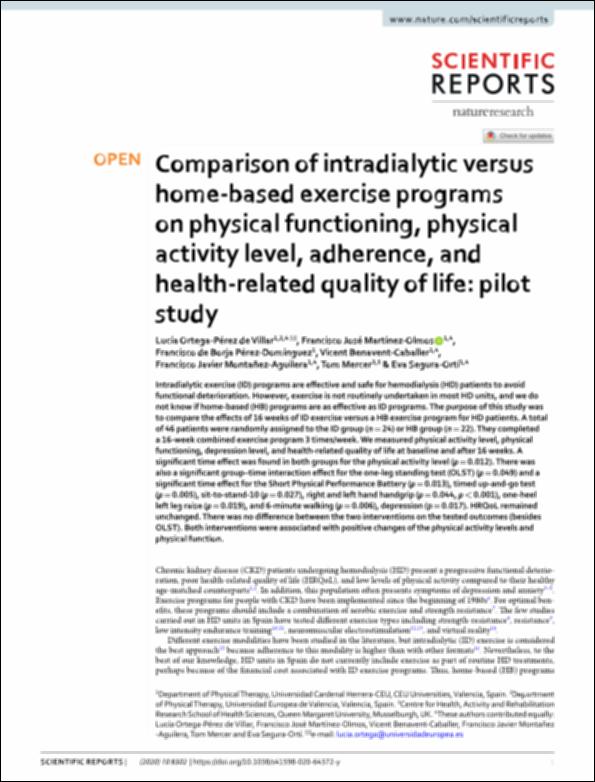Please use this identifier to cite or link to this item:
http://hdl.handle.net/10637/12651Comparison of intradialytic versus home-based exercise programs on physical functioning, physical activity level, adherence, and health-related quality of life: pilot study
| Title: | Comparison of intradialytic versus home-based exercise programs on physical functioning, physical activity level, adherence, and health-related quality of life: pilot study |
| Authors : | Ortega Pérez de Villar, Lucía Martínez Olmos, Francisco José Pérez Domínguez, Francisco de Borja Benavent Caballer, Vicente Montañez Aguilera, Francisco Javier Mercer, Tom Segura Ortí, Eva |
| Keywords: | Exercise - Therapeutic use.; Kidneys - Diseases - Physical theraphy.; Riñones - Enfermedades - Fisioterapia.; Ejercicio físico - Uso terapéutico.; Hemodialysis - Patients - Quality of life.; Hemodiálisis - Pacientes - Calidad de vida. |
| Publisher: | Nature Research. |
| Citation: | Ortega-Pérez de Villar, L., Martínez-Olmos, F.J., Pérez-Domínguez, F.d.B., Benavent-Caballer, V., Montañez-Aguilera, F.J., Mercer, T. et al. (2020). Comparison of intradialytic versus home-based exercise programs on physical functioning, physical activity level, adherence, and health-related quality of life: pilot study. Scientific Reports, vol. 10, art. 8302 (19 may.). DOI: https://doi.org/10.1038/s41598-020-64372-y |
| Abstract: | Intradialytic exercise (ID) programs are effective and safe for hemodialysis (HD) patients to avoid functional deterioration. However, exercise is not routinely undertaken in most HD units, and we do not know if home-based (HB) programs are as effective as ID programs. The purpose of this study was to compare the effects of 16 weeks of ID exercise versus a HB exercise program for HD patients. A total of 46 patients were randomly assigned to the ID group (n = 24) or HB group (n = 22). They completed a 16-week combined exercise program 3 times/week. We measured physical activity level, physical functioning, depression level, and health-related quality of life at baseline and after 16 weeks. A significant time effect was found in both groups for the physical activity level (p = 0.012). There was also a significant group–time interaction effect for the one-leg standing test (OLST) (p = 0.049) and a significant time effect for the Short Physical Performance Battery (p = 0.013), timed up-and-go test (p = 0.005), sit-to-stand-10 (p = 0.027), right and left hand handgrip (p = 0.044, p < 0.001), one-heel left leg raise (p = 0.019), and 6-minute walking (p = 0.006), depression (p = 0.017). HRQoL remained unchanged. There was no difference between the two interventions on the tested outcomes (besides OLST). Both interventions were associated with positive changes of the physical activity levels and physical function. |
| Description: | Este artículo se encuentra disponible en la siguiente URL: https://www.nature.com/articles/s41598-020-64372-y.pdf |
| URI: | http://hdl.handle.net/10637/12651 |
| Rights : | http://creativecommons.org/licenses/by/4.0/deed.es |
| ISSN: | 2045-2322 (Electrónico). |
| Issue Date: | 19-May-2020 |
| Center : | Universidad Cardenal Herrera-CEU |
| Appears in Collections: | Dpto. Enfermería y Fisioterapia |
Items in DSpace are protected by copyright, with all rights reserved, unless otherwise indicated.


